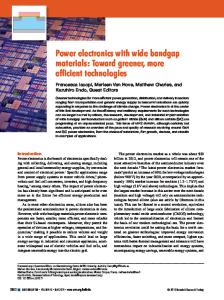A roadmap for future wide bandgap semiconductor power electronics
- PDF / 2,486,791 Bytes
- 6 Pages / 585 x 783 pts Page_size
- 31 Downloads / 331 Views
Importance of power electronics Developments in electronics have thus far been propelled especially by the field of information technology (IT). Improvements in energy savings and efficient usage of electric power are urgent issues for future sustainable development across technology areas. In the near future, a significant amount of renewable energy is anticipated to become available, and more efficient usage of motor-drives and other power-intensive applications is strongly desired. High-performance electric power converters for more efficient motor drives are in demand. Power electronics is a technology for the conversion and control of electric power for energy generation, transmission, storage, and consumption and is a promising technology for future electrical energy management.1 Moreover, electric energy networks are being developed in conjunction with information networks. Much more functionality can be expected for the sophisticated operation of electric energy in many of these areas, which will be increasingly important to society. Power electronics is expected to play an important role for these purposes. This article presents a technology roadmap for power electronics utilizing wide bandgap semiconductors.2 Based on this roadmap, recent progress in silicon carbide (SiC) semiconductor power electronics is reviewed, and future prospects are discussed.
Approaches to next-generation power electronics for the future Power electronics can be applied to a wide range of fields, from IT equipment power supplies to electric power
transmission systems. The semiconductor devices and circuits used exhibit a large variety in capacity, size, and function. In addition, special research and development (R&D) needs exist due to the extreme conditions specific to power electronics equipment, such as high reliability, high tolerance, as well as low loss compared with conventional information electronics primarily composed of Si devices. However, the performance of Si power devices, which is at present primarily used in the field, is now approaching the fundamental material property limits. Since wide-gap semiconductors have superior materials properties highly suitable for high-power switching devices, which is critical for power electronics equipment, these emerging semiconductor devices are drawing increased attention for radical innovations in power electronics. The key components of power electronics are high-power semiconductor devices (transistors and diodes) and electric power converters using these semiconductor devices. In a converter unit, these semiconductor power devices are used as an electrical rectifier or switch, and various electricity specifications (voltage, frequency) are controlled by their complex operation together with passive elements such as capacitors.1 Thus, arbitrary electric power wave forms are generated. Low-loss characteristics, high-speed switching capability, and high-blocking voltage capability of the semiconductor power devices are essential factors in the electric power conversion function. Th
Data Loading...


